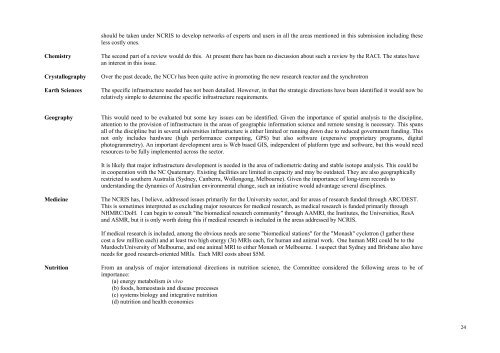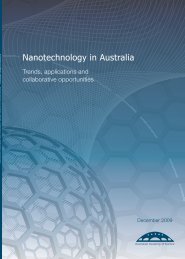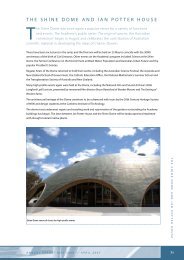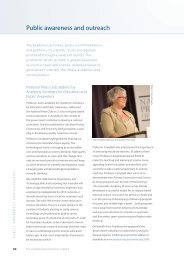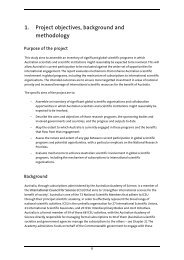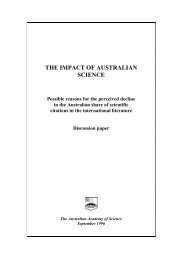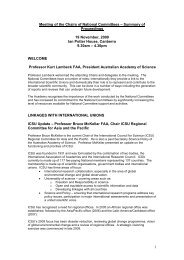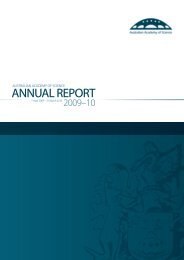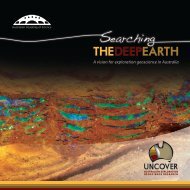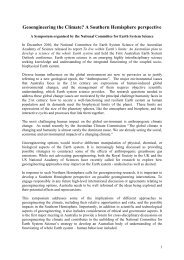Australia's Major National Research Facilities - Australian Academy ...
Australia's Major National Research Facilities - Australian Academy ...
Australia's Major National Research Facilities - Australian Academy ...
Create successful ePaper yourself
Turn your PDF publications into a flip-book with our unique Google optimized e-Paper software.
should be taken under NCRIS to develop networks of experts and users in all the areas mentioned in this submission including these<br />
less costly ones.<br />
Chemistry<br />
Crystallography<br />
Earth Sciences<br />
The second part of a review would do this. At present there has been no discussion about such a review by the RACI. The states have<br />
an interest in this issue.<br />
Over the past decade, the NCCr has been quite active in promoting the new research reactor and the synchrotron<br />
The specific infrastructure needed has not been detailed. However, in that the strategic directions have been identified it would now be<br />
relatively simple to determine the specific infrastructure requirements.<br />
Geography<br />
This would need to be evaluated but some key issues can be identified. Given the importance of spatial analysis to the discipline,<br />
attention to the provision of infrastructure in the areas of geographic information science and remote sensing is necessary. This spans<br />
all of the discipline but in several universities infrastructure is either limited or running down due to reduced government funding. This<br />
not only includes hardware (high performance computing, GPS) but also software (expensive proprietary programs, digital<br />
photogrammetry). An important development area is Web based GIS, independent of platform type and software, but this would need<br />
resources to be fully implemented across the sector.<br />
It is likely that major infrastructure development is needed in the area of radiometric dating and stable isotope analysis. This could be<br />
in cooperation with the NC Quaternary. Existing facilities are limited in capacity and may be outdated. They are also geographically<br />
restricted to southern Australia (Sydney, Canberra, Wollongong, Melbourne). Given the importance of long-term records to<br />
understanding the dynamics of <strong>Australian</strong> environmental change, such an initiative would advantage several disciplines.<br />
Medicine<br />
The NCRIS has, I believe, addressed issues primarily for the University sector, and for areas of research funded through ARC/DEST.<br />
This is sometimes interpreted as excluding major resources for medical research, as medical research is funded primarily through<br />
NHMRC/DoH. I can begin to consult "the biomedical research community" through AAMRI, the Institutes, the Universities, ResA<br />
and ASMR, but it is only worth doing this if medical research is included in the areas addressed by NCRIS.<br />
If medical research is included, among the obvious needs are some "biomedical stations" for the "Monash" cyclotron (I gather these<br />
cost a few million each) and at least two high energy (3t) MRIs each, for human and animal work. One human MRI could be to the<br />
Murdoch/University of Melbourne, and one animal MRI to either Monash or Melbourne. I suspect that Sydney and Brisbane also have<br />
needs for good research-oriented MRIs. Each MRI costs about $5M.<br />
Nutrition<br />
From an analysis of major international directions in nutrition science, the Committee considered the following areas to be of<br />
importance:<br />
(a) energy metabolism in vivo<br />
(b) foods, homeostasis and disease processes<br />
(c) systems biology and integrative nutrition<br />
(d) nutrition and health economics<br />
24


